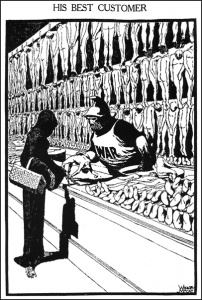
Winsor McCay’s political cartoon is telling of the most basic truth of war.
Three years of war had shown the world the unprecedented depth of the trauma of war. This cartoon created by American artist Winsor McCay portrays a man labeled “war” with hundreds of dead bodies hanging behind him, serving the grim reaper (death) over a counter. The headline reads, “His Best Customer”. World War One, as previously stated, was the world’s first glimpse of all-consuming war. In just two short years, 116,000 Americans died[1]. Given the Wilson administration’s antidemocratic Espionage and Sedition acts, most protest required an exceeding willingness to sacrifice, or an indirect critique of government policy[2]. Much of the antiwar movement centered around a pro-life sentiment. Death is the most inevitable truth of war, and it is what many people fear most. McCay, in this case, appealed to this fear in his cartoon. Political cartoons have long-served as a pithy, accessible form of protest against the government’s actions. McCay’s shows the fear-laden response to increasingly destructive warfare. Like the Women’s Peace March, many were concerned with the preservation of life rather than the triumph of American values and policy; like the Peace March, its message was lost on the government.
[1] GUELZO, ALLEN C. 2018. “The Great War’s Great Price.” National Review 70 (21): 30–34. http://envoy.dickinson.edu:2056/login.aspx?direct=true&db=a9h&AN=132556967&site=eds-live&scope=site.
[2] Thomas, William H.. Unsafe for Democracy : World War I and the U. S. Justice Department’s Covert Campaign to Suppress Dissent, University of Wisconsin Press, 2008. ProQuest Ebook Central, https://ebookcentral.proquest.com/lib/dickinson/detail.action?docID=3444892.
